
The Cleveland Bay is a breed of horse that originated in England during the 17th century, named after its colouring and the Cleveland district of Yorkshire. It is a well-muscled horse, with legs that are strong but short in relation to the body. The horses are always bay in colour, although a few light hairs in the mane and tail are characteristic of some breed lines. It is the oldest established horse breed in England. The ancestors of the breed were developed during the Middle Ages for use as pack horses, when they gained their nickname of "Chapman Horses". These pack horses were cross-bred with Andalusian and Barb blood, and later with Arabians and Thoroughbreds, to create the Cleveland Bay of today. Over the years, the breed became lighter in frame as they were employed more as carriage and riding horses. The popularity of the Cleveland Bay has greatly fluctuated since it was first imported to the United States in the early nineteenth century. Despite serious declines in the population after the Second World War, the breed has experienced a resurgence in popularity since the 1970s, although only around 550 horses existed worldwide as of 2006.
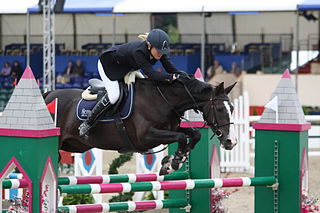
The Selle Français (SF) is a breed of sport horse from France. An athletic horse with good gaits, it is usually bay or chestnut in color. The Selle Français was created in 1958 when several French riding horse breeds were merged into one stud book. The new breed was meant to serve as a unified sport horse during a period when horses were being replaced by mechanization and were transforming into an animal used mainly for sport and leisure.
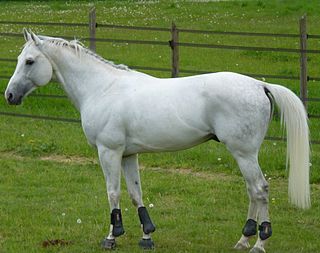
The Anglo-Arabian, also known as the Anglo-Arab, is a horse breed that originated in France by cross-breeding a Thoroughbred with an Arabian. The Anglo-Arabian has origins tracing back to the Limousin Horse. It was officially recognized by Emperor Louis Philippe I and produced by the Haras National du Pin. The Anglo-Arabian has long legs, a refined head, larger hindquarters, and are most commonly seen in gray, bay, or chestnut. To be recognized as an Anglo-Arabian with the Arabian Horse Association, the horse must have at least 25% Arabian blood. There are no color or height restrictions to be registered. Due to its lineage and physique, the Anglo-Arabian is utilized for sports-related activities such as dressage, show jumping, endurance, and cross-country.

The Dole Gudbrandsdal, Dølahest, or Dole is a draft- and harness-type horse from Norway. The Dole Trotter is alternately considered a subtype of the Dole Gudbrandsdal and a separate breed; it is also considered a part of the coldblood trotter type. The Dole Gudbrandsdal is a small draft horse, known for its pulling power and agility, while the Dole Trotter is a smaller, faster horse used for harness racing. The two types were previously commonly interbred, but the studbooks have been separate since 2000 and since 2016 the criteria for entry into the Gudbrandsdal horse studbook has required a strict critique of eligible mares. The Dole is originally from the Gudbrandsdal Valley, and is probably descended in part from the Friesian horse. Over time, the breed has had Thoroughbred, Arabian, and other breeds added in, especially during the creation of the Dole Trotter in the 19th century. The first studbook was created in 1941, and the current breed association was formed in 1947. Although originally used mainly as a pack horse, today, the heavier Dole type is used mainly for agricultural purposes. The Dole Gudbrandsdal been crossed with other breeds to develop horses for harness racing and riding.
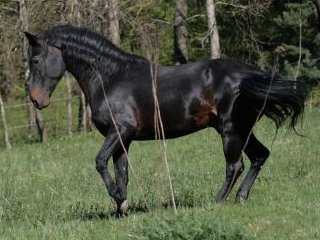
The Kabarda, Kabardin or Circassian horse is a breed from the Caucasus, originating from Eastern Circassia, currently part of the Kabardino-Balkaria region of Russia. These horses are noted for their endurance and ease to adapt in difficult environments.
The Welara is a part-Arabian pony breed developed from the Arabian horse and the Welsh pony. It was originally bred in England by Lady Wentworth at the Crabbet Arabian Stud in the early 1900s from imported Arabian stallions and Welsh pony mares. Breeding then spread throughout North America. In 1981, a breed registry was formed in the United States, and a studbook began to be published. They are used for many disciplines of English riding, and are known for their refinement, hardiness and spirit.

The Budyonny is a breed of horse from Russia. It was bred as a military horse after the Russian Revolution of 1917; in the twenty-first century it is used as an all-purpose competition horse and for driving.

The Boulonnais, also known as the "White Marble Horse", is a draft horse breed. It is known for its large but elegant appearance and is usually gray, although chestnut and black are also allowed by the French breed registry. Originally there were several sub-types, but they were crossbred until only one is seen today. The breed's origins trace to a period before the Crusades and, during the 17th century, Spanish Barb, Arabian, and Andalusian blood were added to create the modern type.
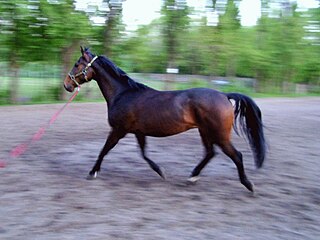
The Malopolski is a Polish horse breed developed in the 19th century in Lesser Poland, Polish Małopolska, hence the name. It is versatile breed, used today for light draft and under-saddle work. It was developed mainly from native Polish horses crossed with Thoroughbreds and Arabians, and a 2006 study shows a strong genetic presence of Thoroughbred bloodlines within the breed today. Population numbers have been in decline since the late 20th century, but genetic studies show little danger of inbreeding at this time.

The French Saddle Pony, also called the Poney Français de Selle, is a pony breed developed as a sport pony for children and smaller adult riders. It was initially developed in 1969 as the Poney de Croisement, and in 1972 a stud book was created. In 1991 the stud book was closed and the breed renamed to Poney Français de Selle. The breed combines a mix of French and British pony breeds, as well as Thoroughbred and Arabian blood, to create the horse seen today. Due to the large number of breeds used to create the French Saddle Pony, there is not yet a defined set of physical characteristics for the breed, although all tend to be suited for competition in English riding disciplines, including dressage, show jumping and three-day eventing. They fill a similar role as the British Riding Pony and the German riding pony.

The Pleven breed of horse is essentially Anglo-Arabian, and the breed was officially recognized in 1951. It is a competition horse with a natural jump and has free-flowing gaits.

The Novokirghiz or New Kirghiz is a modern Kyrgyz breed of horse. It was developed in the Kirghiz Soviet Socialist Republic in the mid-twentieth century through cross-breeding of the traditional Kyrgyz Horse of the region with introduced horses of Thoroughbred, Don and Anglo-Don stock.
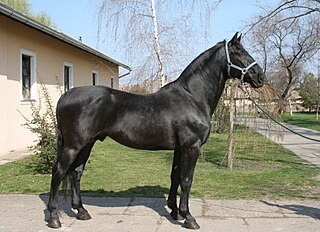
The Nonius is a Hungarian horse breed named after its Anglo-Norman foundation sire. Generally dark in color, it is a muscular and heavy-boned breed, similar in type to other light draft and driving horses. The breed was developed at the Imperial Stud at Mezőhegyes, Hungary by careful linebreeding. Originally bred to serve as a light draft and utility horse for Hungary's military, the breed became a useful agricultural horse during the 20th century. The depredations of World War II significantly reduced the Nonius' population, and in the decades after the war, a downturn in the usage of horses in Hungary sent many members of the breed to slaughter. Today the breed is bred by preservationists and is used in agriculture, leisure riding, and competitive driving sports. The largest numbers of Nonius horses are still found at Mezőhegyes, with representatives in other eastern European nations as well.

The Deutsche Reitpony or German Riding Pony is a very popular pony breed in Germany. It is described as a "miniature warmblood" with refined, horse-like characteristics that make it suitable as both a children's pony and as a mount for sport horse competition in Europe. Originally bred in Germany and later throughout Western Europe, the breed is relatively new to North America.
Origin of the Uzunyayla breed dates to 1854 in Turkey. Ancestors of the breed came from the Caucasus, and it is believed that they were of the Kabarda (horse) breed. They were bred pure in Turkey until 1930, when Anadolu pony and Nonius (horse) blood was introduced.
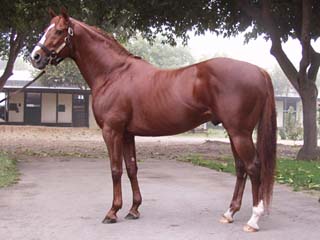
The Thoroughbred is a horse breed developed for horse racing. Although the word thoroughbred is sometimes used to refer to any breed of purebred horse, it technically refers only to the Thoroughbred breed. Thoroughbreds are considered "hot-blooded" horses that are known for agility, speed, and spirit.

The Anglo-Norman horse is a warmblood horse breed developed in Lower Normandy in northern France. A major center of horse breeding, the area had numerous regional types that were bred to one another and then crossed with Thoroughbreds to form the Anglo-Norman. Various body types developed within the Anglo-Norman breed, two of which were split off to form the Norman Cob and French Trotter. The remaining types were eventually standardized, although there remained some criticism of the "hybrid" nature of the breed's conformation. However, it is successful as an international sport horse, especially in the sport of show jumping. The Anglo-Norman also contributed to the development of several other breeds in Europe and Asia.
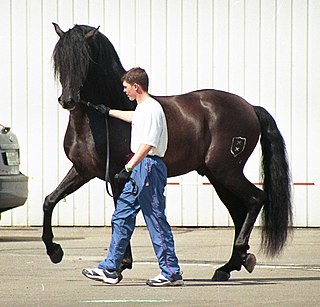
The Andalusian, also known as the Pure Spanish Horse or PRE, is a horse breed from the Iberian Peninsula, where its ancestors have lived for thousands of years. The Andalusian has been recognized as a distinct breed since the 15th century, and its conformation has changed very little over the centuries. Throughout its history, it has been known for its prowess as a war horse, and was prized by the nobility. The breed was used as a tool of diplomacy by the Spanish government, and kings across Europe rode and owned Spanish horses. During the 19th century, warfare, disease and crossbreeding reduced herd numbers dramatically, and despite some recovery in the late 19th century, the trend continued into the early 20th century. Exports of Andalusians from Spain were restricted until the 1960s, but the breed has since spread throughout the world, despite their low population. In 2010, there were more than 185,000 registered Andalusians worldwide.

A part-Arabian, partbred Arabian or, less precisely, half-Arabian, is a horse with documented amounts of Arabian horse breeding but not a purebred. Because the Arabian is deemed to be a breed of purebred horse dating back many centuries, the modern breed registries recognized by the World Arabian Horse Organization generally have tightly closed stud books which exclude a horse from registration if it is found to contain any outside blood. However, Arabian breeding has also been used for centuries to add useful traits to countless other horse breeds. In the modern era, crossbreeding has been popular to combine the best traits of two different breeds, such as color, size, or ability to specialize in a particular equestrian discipline.

















